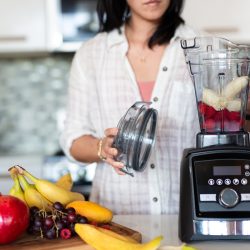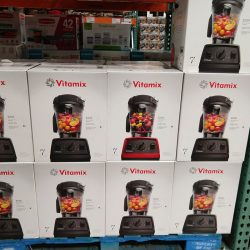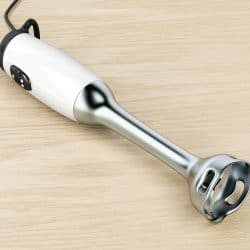You are probably wondering if you can chop vegetables with a blender. You have come to the right place! We have researched all about chopping vegetables by using a blender. Here you will learn about the dos and don'ts of chopping vegetables in a blender.
You can chop vegetables with a blender. In order to do so, the blender you use will need to have a pulse and chop function. If the vegetables are large, they have to be cut up prior to putting them in the blender.
Keep reading to find out if you can use a blender without liquid and whether or not the Vitamix blender can chop vegetables. We'll discuss some specific veggies like chopping carrots in a blender or using a blender to chop onions. Finally, we'll cover what you should not put in a blender.

How To Use a Blender to Chop Vegetables
In order to chop vegetables in your blender, you need to cut your vegetables up into approximately one to two-inch pieces. Next, you cover your vegetables in a generous amount of water. Be sure the water covers your vegetables completely. Use the chop or pulse function on low.
Check the vegetables for your desired consistency at 30-second intervals. After chopping your vegetables, strain them, and you are good to go!
Can you use a blender without liquid?
Blenders are made to have liquid in them. Using the right amount of liquid is imperative. If you do not use enough liquid when blending, your result will be lumpy. When you use too much liquid, it will prevent the blades from coming in contact with the vegetables. Using the right amount of liquid compared to your vegetables will result in the pieces of vegetables being able to move around consistently. This will make it so you are able to blend your vegetables evenly.
Can the Vitamix chop vegetables?
You can chop vegetables with a Vitamix more easily than a standard blender. Vitamix blenders are quite powerful. Because of this, you do not have to chop your vegetables as small as you normally would. About a quarter of an apple is the right size for a Vitamix blender.
Long, skinny vegetables such as carrots can actually be added through the lid while the Vitamix is already running. One unique feature of the Vitamix is its ability to chop through thicker portions of food. Use speed one for thicker chopping.
Click here to see this Vitamix blender on Amazon.
Can I chop carrots in a blender?
Even though carrots are hard, you can chop carrots in a blender. You simply need to cut your carrots into one to two-inch pieces before you put them in your blender. You can also grate carrots in a blender if you have a grating blade. A Vitamix blender is perfect for chopping carrots without a problem.
Can you use a blender to chop onions?
You can use a blender to chop onions by utilizing the pulse or chop function on your blender. Be sure to cut your onions into smaller pieces before putting them in your blender. Quartering your onion is a good estimate of how many pieces you should have before chopping an onion in your blender. If you are using a Vitamix blender, you do not have to chop your vegetables as much as you normally would.
What should you not put in a blender?
Hot Liquid
One thing you do not want to put in a blender is extremely hot liquid. This is because the steam from hot food will become pressurized. When anything becomes pressurized, it has the potential to explode. As you can likely imagine, if a hot liquid was to build up pressure in your blender, the lid will come flying off, and the food will explode out, which would burn you.
If you want to puree hot liquid, using an immersion blender is the safest option. Alternatively, allow the liquid to cool before putting on the lid and blending it.
Click here to see this immersion hand blender on Amazon.
Thick and Starchy Foods
Thick and starchy foods are not suggested to put in blenders. This is because the combination of blades with speed will overwork the potatoes, for instance. When potatoes are overworked, they let off an excessive amount of starch. In this case, mashed potatoes do not become like your typical mashed potatoes; they become pasty instead. A ricer or a potato masher will provide a more enticing texture.
Dough
You do not want to put dough into your blender for the same reason that you should not put thick food in your blender. Dense foods make it so that the blades have difficulty turning, which, in turn, causes the motor to work harder. If the motor is working too hard, it will overheat. Whenever appliances overheat, they have the potential to start an electrical fire. A stand mixer is better for mixing dough.
Click here to see this 6.5 Qt stand mixer on Amazon.
Dried Fruit
Another thing you do not want to put in your blender is dried fruit. Whenever you want to have dried fruit in your smoothie or whatever you are making, it is best to add it after finishing the blending part. If you are not satisfied with that, mince your dried fruit or let it soak in warm water to soften before adding it to your mixture.
Frozen Food
When you want to put frozen food into the blender, set it out first so that it can thaw. For certain frozen foods, it is a good idea for you to put the food in a bowl to catch the condensation released during the thawing process. The recommended time for thawing frozen food is about 10 to 15 minutes. Foods that have already been cut into smaller pieces work best.
The main reason you do not want to put hard frozen foods in your blender is that they can break the blender. By break, we mean it has the potential to shatter the pitcher, so do not try it.
Ice Cubes
Whole ice cubes do not work well in all blenders. Like frozen food, blending whole ice cubes can dull or break the blades. Whole ice cubes can break the pitcher too. It is better to use crushed ice instead.
Meat
Meat does not fare well in blenders. If your goal is to make it soft for something like baby food, go ahead and put it in your blender. Otherwise, the meat will lose the texture that you want it to have once it is blended.
Whole Spices
Whole spices do not blend well by way of a blender. The shape of the pitcher and how the blades are made cause blenders to not be able to blend whole spices. A spice blender will work as a great substitute.
Click here to see this spice blender on Amazon.
Coffee Beans
You can grind coffee beans in a blender if you use a very small amount and use the pulse function, but a grinder works much better than a blender. If you use a blender for this purpose, the coffee beans will probably wear down the blades over time. Using a blender for coffee beans will also result in a less than desirable taste, so stick with a grinder for this one. Your spice blender is also useful for grinding coffee beans.
Click here to see this coffee grinder on Amazon.
Bones
Do not ever put bones in a blender. They will cause the blades to jam, and there is a chance of breaking the pitcher. Fishbones are small and are not likely to harm your blender but can also jam the blades. If you blend fish that has bones in it, use an ample amount of water or liquid to ensure it moves continuously while being blended.
Certain Vegetables
Some vegetables do not turn out very well in a blender. For example, raw celery and broccoli become stringy when blended. Cauliflower is another vegetable that does not fare well in a blender. Most people want a cauliflower rice consistency rather than chopped cauliflower. A food processor works better for cauliflower.
Click here to see this 7-in-1 food processor on Amazon.
Dehydrated Food
Foods that have been dehydrated do not blend well. They can damage the blender and dull the blades. Soak your dehydrated food to soften it before putting it into your blender.
Strong Foods
You may want to avoid putting strong-smelling or strong-tasting food in your blender. Foods such as garlic, ginger, jalapenos, or chili peppers can end up leaving an odor or spice flavor behind, which will transfer to whatever else you blend. As long as you cook these and blend them with other foods rather than by themselves, you should be okay.
In Closing
You can chop vegetables in a blender. Knowing which vegetables work best and which do not work very well is important. Unless you are using a Vitamix blender, always cut your vegetables into smaller pieces before adding them to your blender.
Before you go, check out the following links to learn more about what you can do with your blender:
5 Ways To Crush Ice Without A Blender
Does A Blender Work As A Food Processor? [The Answer Might Surprise You!]







![Vitamix boxes displayed at a store, Can I Blend Hot Liquids In My Vitamix? [Yes! How To Tips]](https://kitchenseer.com/wp-content/uploads/2022/09/Vitamix-boxes-displayed-at-a-store-250x250.jpg)




